Chapter 3: Planning for Low-Tech Process-Based Restoration
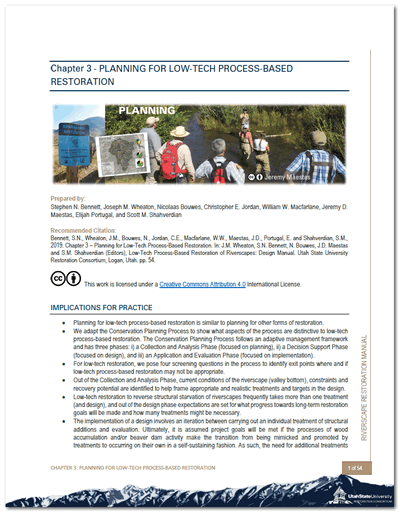 The third chapter covers planning for low tech process-based restoration. We illustrate the process with the NRCS Conservaton Planning Process, and show what aspects are distinctive to low-tech restoration. Speifically, the following topics are covered:
The third chapter covers planning for low tech process-based restoration. We illustrate the process with the NRCS Conservaton Planning Process, and show what aspects are distinctive to low-tech restoration. Speifically, the following topics are covered:
- Where to Plan?
- Phase 1: Collection & Analysis
- Phase 2: Decision Support & Design
- Phase 3: Application & Evaluation
- The Low-Tech Extension of Conservation Planning Process
Chapter 3 also has appendices on:
- Appendix 3A: Parallels Between Different Planning Frameworks for Restoration
- Appendix 3B: Mapping Synthesis of Problems & Opportnities Problems & Opportunities
- Appendix 3C: Mapping Valley Bottom for Assessing Space
- Appendix 3D: Assessing Risk to Property, Infrastructure, and Public Safety
- Appendix 3E: Assessing Riparian Conditions to support Wood accumulation
- Appendix 3F: Assessing Potential for Beaver Dam Activity
- Appendix 3G: Structure Level Adaptive Management
 Full PDF available for free at ResearchGate, but ResearchGate requires a free account.
Full PDF available for free at ResearchGate, but ResearchGate requires a free account.
Implications for Practice

- Planning for low-tech process-based restoration is similar to planning for other forms of restoration.
- We adapt the Conservation Planning Process to show what aspects of the process are distinctive to low-tech process-based restoration. The Conservation Planning Process follows an adaptive management framework and has three phases: i) a Collection and Analysis Phase (focused on planning), ii) a Decision Support Phase (focused on design), and iii) an Application and Evaluation Phase (focused on implementation).
- For low-tech restoration, we pose four screening questions in the process to identify exit points where and if low-tech process-based restoration may not be appropriate.
- Out of the Collection and Analysis Phase, current conditions of the riverscape (valley bottom), constraints and recovery potential are identified to help frame appropriate and realistic treatments and targets in the design.
- Low-tech restoration to reverse structural starvation of riverscapes frequently takes more than one treatment (and design), and out of the design phase expectations are set for what progress towards long-term restoration goals will be made and how many treatments might be necessary.
- The implementation of a design involves an iteration between carrying out an individual treatment of structural additions and evaluation. Ultimately, it is assumed project goals will be met if the processes of wood accumulation and/or beaver dam activity make the transition from being mimicked and promoted by treatments to occurring on their own in a self-sustaining fashion. As such, the need for additional treatments versus recognizing the project has achieved its goals is evaluated with respect to the sustainability of these processes.
Recommended Citation
- Bennett, S., Wheaton, J., Bouwes, N., Shahverdian, S., Macfarlane, W.W. and Portugal, E. 2019. Chapter 3 - Planning for Low-Tech Process-Based Restoration. In: Low-Tech Process-Based Restoration of Riverscapes: Design Manual - Version 1.0. Wheaton JM, Bennett S, Shahverdian S, and Maestas JD, (Editors). Utah State University Wheaton Ecogeomorphology & Topographic Analysis Lab. Logan, UT. 57 pp. DOI: 10.13140/RG.2.2.15815.75680.
Planning Distilled
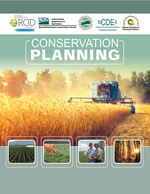 These slides walk through a standardized Conservation Planning Process from NRCS (2007), and how that differs for low-tech process-based restoration.
These slides walk through a standardized Conservation Planning Process from NRCS (2007), and how that differs for low-tech process-based restoration.
Related Resources
- Condition & Impairment Assessment - WATS 5340 Design Capstone Class Resources
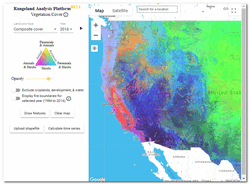
Raneland Analysis Platform -e.g. for mapping annual cover, perrenial cover, shrub cover, tree cover, bare ground cover. - This can be helpful for inventorying vegetative resources and how they change through time.
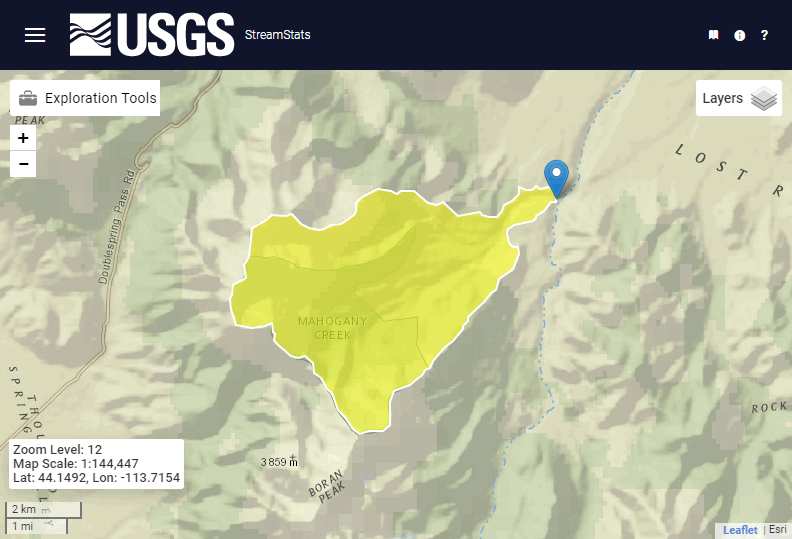
USGS StreamStats - e.g. for estimating baseflow and highflow frequency statiscs. This can be used to consider the question - Does the riverscape have the flow-regime to "let the river do the work", and how long it might take for the work to be done?
Riverscapes Tools
RCAT(Riparian Condition Assessment Tool) is helpful for assessing riparian conditions, the causes of departure from historic conditions and looking at recovery potential within the valley bottom. Specifically, RCAT provides one way for network-scale assessment of the question Are the woody resources present or could they be (via restoration) to support and sustain process of wood accumulation?. BRAT(Beaver Restoration Assessment Tool) is useful for condition assessment as it pertains to developing expectations for beaver dam building. Specifically, BRAT provides one way for network-scale assessment of the question of Can (or could via restoration) the riverscape support beaver dam activity?
References
- Bouwes, N., Bennett, S. and Wheaton, J., 2016. Adapting Adaptive Management for Testing the Effectiveness of Stream Restoration: An Intensively Monitored Watershed Example. Fisheries, 41(2): 84-91. DOI: 10.1080/03632415.2015.1127806
- NRCS, 2007. Chapter 2: Goals, Objectives, and Risk. In: J. Bernard, J. Fripp and K. Robinson (Editors), Stream Restoration Design: Part 654 - National Engineering Handbook. United States Department of Agriculture - Natural Resources Conservation Service, Washington D.C., pp. 34
- Skidmore, P.B., Thorne, C.R., Cluer, B.L., Pess, G.R., Castro, J.M., Beechie, T.J. and Shea, C.C., 2011. Science base and tools for evaluating stream engineering, management, and restoration proposals. U.S. Dept. Commer., NOAA Tech. Memo. NMFS-NWFSC-112, 255 p.
- Yochum, S. E. 2016. Guidance for stream restoration and rehabilitation. US Department of Agriculture, Forest Service, National Stream and Aquatic Ecology Center. Technical Note no. TN-102.2, 2016.


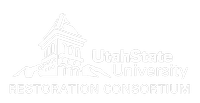
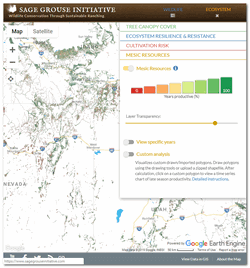


 Riverscapes Models & Tools for low-tech PBR
Riverscapes Models & Tools for low-tech PBR